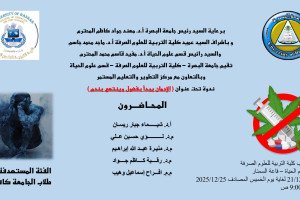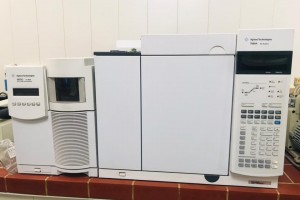
The College of Education for Pure Sciences, Department of Chemistry, University of Basra, discussed a doctoral thesis on the preparation, diagnosis and analytical study of some new chelating reagents and their complexes with copper (II) and mercury (II) and the study of their biological effectiveness
The thesis managed by the researcher (Hassanin Abdel Samad Abdel Majid) included the preparation of azo compounds and lipid base compounds derived from the two pharmaceutical aminos (4-amino methyl benzoate and 4-amino ethyl benzoate) and some of their complexes and their diagnosis by infrared, visible, ultraviolet, mass spectrometry and nuclear resonance spectroscopy The magnetic field of the proton (1H NMR) and carbon (13C NMR). Analytical studies such as the effect of pH and the effect of different polar solvents on the electronic absorption spectra of azo compounds, as well as a spectroscopic study of its complexes with ions of copper (II) and mercury (II), also dealt with the applicability of Beer's law and the sensitivity of the spectroscopic method. The study also included conducting some applications, as some solutions of these compounds were used in the determination of the nitrite ion, and the biological activity of all compounds against two types of bacteria and fungi was also studied.
Thesis objectives:
Preparation of azo compounds (A10-A1) and Schiff base compounds (S5-S1) from medicinal amines derived from 4-aminobenzoic acid ester) as a base part with medicinal phenols and various aldehydes, and preparation of solid complexes of copper (II) and mercury (II) with two compounds Azo (A1 and A6), and copper (II) complexes with Schiff base compounds (S5-S1) and their characterization by various methods to support the proposed formulas. And conducting some analytical studies on azo compounds, such as studying the effect of some solvents of different polarity on their absorption peaks, calculating the ionization and protonation constants with different acidic solutions and determining the isostatic points. And study the optimal conditions for the formation of azo complexes. And carrying out some applications on compounds, such as using solutions of azo compounds (A2 and A7) in the determination of nitrite, as well as studying the biological antibacterial activity of all compounds against two types of bacteria and fungi.
Thesis concluded
The diagnostic methods of azo compounds, Schiff base compounds and their complexes confirmed the validity of the proposed structures. The results of analytical studies and thermogravimetric analysis showed that mercury (II) complexes are more stable than copper (II) complexes with azo compounds (A1 and A6). In addition, copper (II) complexes with lipid base compounds are more stable than its complexes with two compounds azo; Beer's law was applied in the determination of copper (II) and mercury (II) spectroscopically using solutions of azo compounds (A1 and A6) at the greatest wavelengths, and the high linear method showed the applicability. The method used for determination of nitrite ion spectroscopically from two azo compound solutions (A2 and A7) is easy, sensitive, fast, accurate and highly precise. The results of the biological study showed that Schiff base compounds are more effective against bacteria and fungi. Azo compounds are preferable to Schiff base compounds in analytical studies due to the dissociation of the latter in aqueous media.








